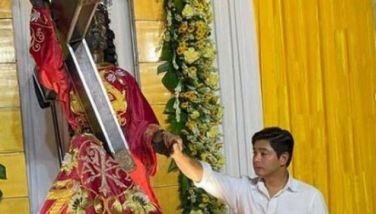Radio and redemption with the P.O.P.E. (Paolo O. Pirlo, Evangelist)
MANILA, Philippines - Tamaan ka Sana ng Pag-ibig ng Diyos is the first segment in the trilogy called Ka2waan sa Radyo airing over DZIQ every Saturday from 1 to 6 p.m. The program on band width 990 AM might as well be called Kaligtasan, Katuwaan and Kalikasan as the first hour is about things spiritual, the next three tweaks current issues with the pop and zany humor of Jojo Alejar and Isko Salvador, and the last hour is a wake-up call for the environment with Chito Rivera.
Tamaan is an evangelical effort in a mass medium that still enjoys the widest reach in a country of over 92 million people, biding well with the needs of the time, as its dominant Roman Catholic church is assailed by many challenges, from rancorous divisions within the prelates’ ranks to its stand on reproductive health issues that is in friction with P-Noy’s administration.
Its anchor, Rev. Fr. Paolo O. Pirlo, is a member of the congregation, Sons of Holy Mary Immaculate (SHMI), a religious Pontifical order founded by the saintly Fr. Joseph Frassinetti in Genova, Italy. Its charism is to promote religious and priestly vocations with the assistance of the Virgin Mother.
In a highly secularized milieu, the tradition of the church is floundering, with Catholic theologians and Scripture scholars often turning off the flock with their pedantic pontifications inaccessible to the vast majority of the masses. Tamaan seeks to deliver the good news in a fun yet meaningful manner, i.e., bringing it close to their lives. Consider the theme Fr. Paolo chose for the Christ the King Feast celebrated during the last Sunday of the liturgical year before Advent or Christmas: Respecting everyone regardless of social status, as Jesus lived in humility despite being the son of God. On air, he relates the anecdote that never fails to make his churchgoers at the seminary chapel in Isabella de Rosis St., Multinational village roll down the aisles with laughter:
“I was invited for a feast at Nunciature in Taft Ave., one time and I was riding my red Honda motorbike, wearing a red raincoat and red helmet. The guards shooed me away, shouting, ‘Hindi kami nag-order ng Pizza Hut!’ Patiently, I took off my riding gear, revealing my sutana. The guards went to a panic, stuttering: Sorry po, Father. I told them: ‘You are today’s Pontius Pilate, who only recognized the vestments of the high priests like Caiphas and washed his hands off the carpenter from Nazareth.’ When it was time to replace my red motorbike, I decided on an Italian brand this time, of course the Vespa (Italian for wasp), manufactured by Piaggio — the first one to own this scooter in the Philippines. But the only available color was yellow, and so, when I went back to the Nunciature, you know what happened. They thought I was delivering Yellow Cab Pizza! So now, my motorbike is White!â€
Like the venerable Fr. Frassinetti, Fr. Paolo was born in Genova, Italy. He obtained his Bachelor in Theology in 1989 in Pontificial Universita’ Urbania, Rome and his Licentiate in Sacred Theology and Master in Higher Religious Studies in 1992 from the University of Sto.Tomas in 1992. Since his assignment in the Philippines in 1989, Fr. Paolo has kept himself busy, like the founder of his order, with search-ins for young boys with priestly vocations, writing religious books and expanding the spiritual and cultural formation of the flock that come under his care in the new SHMI parishes at Levitown, Parañaque and in Salawag, Cavite.
Unlike the fire and brimstone evangelists of other denominations, Fr. Paolo’s style is conversational and friendly, thus attracting those who are more inclined to the ways of the world, especially on a Saturday, when they are unwinding from the salt mines and in a relax mode. He makes the effort to inform the listeners about church history, without intimidating them with arcane facts, like taking them back to the Cristero War (1926 to 29) also known as La Cristiada, a popular uprising and attempted counter-revolution against the anti-Catholicism of the ruling Mexican government, where the rebels called themselves Cristeros, invoking the name of Jesus Christ under the title of “Cristo Rey†or Christ the King.
But more important, he perseveres to inspire the listeners about salvation, exhorting them to be hopeful, to endure moments of trials and oppressions. Speaking in colloquial Tagalog, he tells them: “H’wag tayo mawawalan ng pag-asa kapag may mga dinadaanang problema. Kapag nanghihina tayo, isigaw natin. Viva Cristo Rey, Long Live Jesus Christ! Siya ang tagapagligtas na hindi kailanman magsasawang tumulong sa atin, tulad ng isang tunay na hari na tagapagtanggol ng lahat ng kanyang nasasakop.â€
Pope Pius XI, who wore the ring of the fisherman from 1922, inherited the bitter fruits that had led to World War I and could already see new problems that would eventually plunge the world into World War II. Against the auguries of this looming tragedy, he wrote his 1925 encyclical Quas Primas, setting up the feast of Christ the King.
Longing for lasting peace, the pope prefaced his encyclical: “That these manifold evils in the world were due to the fact that the majority of men had thrust Jesus Christ and His holy law out of their lives; that these had no place either in private affairs or in politics; and that, as long as individuals and states refused to submit to the rule of our Savior, there would be no really hopeful prospect of a lasting peace among nations.â€
After blessing a condominium unit at the 20th floor of 1 Rockwell’s West Tower, Fr. Paolo pointed to the lighted off ramp of the flyover connecting the Lopez-developed enclave with EDSA and told another story, which he shared on his opening broadcast of Tamaan:
“Everytime I have to pass bridges and promontories, I slow down a bit because I was almost killed when my motorbike slid off the road one time. I lay sprawled on the road and was afraid to open my eyes lest I find myself face to face with you-know-who. But when I did, I saw a policeman, and I knew I was still in the Philippines and not in the regions below. Kaya tama pala ang sabi ng mga seminarians sa akin: Masamang damo, matagal mamatay!â€â€™
But levity aside, Fr. Paolo was unscathed from this road mishap, proof that the Lord is looking out for this evangelist, who, like other missionaries from Europe, has left the comforts of home to make this country his own. One is reminded of what the Italian Ambassador to the Philippines Luca Fornari described as the despicable deaths of Italian priests Fausto Tentorio last year and Tulio Favali in 1985. These two priests, both belonging to the Pontifical Institute for Foreign Mission (PIME), lie beside each other in a grave inside the cemetery of the Bishops Palace in Kidapawan City.
Fr. Favali’s murder is remembered by former Sen. and Presidential Spokesman, Rene Augusto Saguisag (also a popular guest at Katuwaan) and the prosecution of the Manero brothers.
“Every trial date, I would take the PAL 2 a.m. Bulilit flight to Davao, and from there board a bus for Kidapawan. Bishop Orlando Quevedo was our gutsy host. Fr. Peter Geremia (the intended victim of the Maneros) would drive me around. Nuns would escort me to Davao for the return flight. I was not around for the conviction of the paramilitary murderers who looked askance at those serving the people, seeing them as ‘subversives’ to be dispatched to the Promised Land.â€
Fr. Paolo ruminates saying Mass one time at the National Penitentiary in Muntinlupa which Norberto Manero, alias Kumander Bucay, attended: “I was thinking of how so many witnesses told the story of how this convicted prisoner splattered the brains of my fellow Italian in the highway after setting his motorbike on fire.†It will be recalled that Fr. Geremia forgave Manero soon after his release from prison on a presidential pardon by former President Gloria Macapagal Arroyo, and that the reformed convict visited the tomb of Fr. Favali to manifest his repentance.
Another anecdote that he never tires telling is how he became a priest. His mother wanted to become a nun, having come from a traditional Italian family, whose ultimate dream is to have a son or daughter take the religious vows. Being unable to enter the convent, she persevered in her duties as wife and mother and her boon came when son Paolo became a priest. “And so, when I celebrated my first Mass, our entire village came, the church was full of our relatives and we had a fiesta, with so much food and wine as everybody wanted to be part of the action. After all, it was not every day that a clan produces a priest — they were so proud of me! The next day, on my second Mass, there were only three of us: Myself, my sacristan and an old, old man who was deaf. So, when it came to the part when I had to say: ‘The Lord be with you,’ the ‘dynasaur’ shouted: Ano daw? His question echoing through the cavernous empty church.â€
Those who have known Fr. Paolo for a long time know that he lives what he preaches. He incarnates Christ as a champion of the poor and downtrodden. Anyone who knocks on the door of his seminary will never be turned away empty handed. He never commodifies the services of his church — ministering baptisms, weddings, blessings and anointing the sick without recompense, going to places near and far in his Vespa without fanfare, after a mere text or e-mail. Whether it is holy water or a song (he can perform a mean Volare at the drop of a hat) that his people needs, he will gladly give. For the Christmas season, he gave this message:
“May Jesus be more important than your mobile phone, Mary more interesting than your Facebook page, and the Bible more enlightening than your Twitter account.†In vintage Pirlo fashion, he rebukes our attachment to worldly concerns via the pernicious gadgets and social media with kind concern.
Advertising and PR veteran Teddy Pereña, who manages the Katuwaan radio program, approached Fr. Paolo for his segment, believing that the priest can bring the news of salvation to the nooks and crannies of the Filipinos’ homes here and abroad with a breath of fresh air. With live video streaming at DZIQ.AM in this flagship AM radio station owned by Trans-Radio Broadcasting Corporation with studios located at the Media Resources Building, Mola cor. Pasong Tirad Sts., Brgy. La Paz, Makati City, tuners can see and hear the P.O.P.E. in his soundproof pulpit as he brings us close to redemption. His Saturday sharing with his assistant, Bro. Francis, is the best reminder of Fr. Frasenetti’s Alliance of Peace Prayer centering on following the will of God:
“Therefore, I ask You for nothing else.
Neither for possessions, nor for life, nor for death,
I ask You for nothing.
In this way, let there be harmony
between Your will and mine.
May Your mercy be in me and in everybody
now and forever. Amen.â€
This year, we celebrate the golden anniversary of Vatican II, which caught the world’s imagination in 1962, with its goal of aggiornamento — renewal or updating to connect to the modern world, as the good Pope John XXIII then advocated, leading to the promotion of Christian unity. If Tamaan ka sana ng Pag-ibig ng Diyos with Fr. Paolo’s pitch at redemption does not strike us like a bolt of lightning, what will?
- Latest
- Trending































